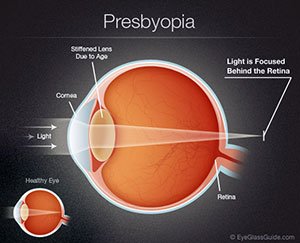Key Takeaways
- Understanding presbyopia and its impact on daily life
- Exploring practical methods to address presbyopia
- Integrating healthy habits to support vision health
- Utilizing available resources to ensure proper eye care
What Is Presbyopia?
Presbyopia is a common age-related condition affecting the ability to see objects up close. Unlike other eye disorders, it is a natural part of aging, with symptoms including difficulty reading small print, eye strain, and headaches. This condition results from the hardening of the eye’s lens, which reduces its flexibility and ability to focus on nearby objects. While entirely natural, it can be frustrating for those who experience it, often leading to a need for reading glasses or other corrective measures.
Presbyopia affects nearly everyone to some degree as they age, making it a widespread issue that garners significant attention. Understanding its causes and symptoms is the first step toward effectively managing the condition. Regular eye examinations and awareness of changes in your vision can help in early detection and timely correction.
Symptoms and Early Signs
For those wondering what is presbyopia, it is a condition that typically becomes noticeable in individuals over the age of 40. One of the first indicators of presbyopia is the need to hold reading material at arm’s length. This adjustment is a subconscious effort to focus the text more clearly. Other symptoms include difficulty focusing on close objects, experiencing eye fatigue after tasks requiring close vision, such as reading or sewing, and blurry vision when looking at objects at a normal reading distance. These signs typically become more pronounced in low-light conditions or after prolonged reading periods.
Another common symptom is having to squint to see clearly at close distances. This can lead to tension headaches and neck strain due to the awkward positions one might hold to bring objects into focus. Recognizing these early signs allows for timely intervention, ensuring that the effects of presbyopia can be managed more effectively.
Effective Management Strategies
While presbyopia is an unavoidable part of aging, several strategies can help manage its impact effectively:
- Reading Glasses: These are simple and affordable solutions often reached for first by those with presbyopia. They are available over the counter and come in various strengths. Reading glasses are a convenient solution for those who do not require vision correction for other distances.
- Prescription Eyewear: For those needing more than occasional help, prescription lenses designed for continuous wear can be particularly beneficial. These glasses are tailored to the individual’s specific vision needs, providing clear vision for both near and far distances and reducing the need to switch between glasses.
- Contact Lenses: Specialized multifocal contact lenses can accommodate both near and far vision, providing many users with a more aesthetically pleasing option. These lenses come in various designs, such as concentric rings or aspheric lenses, offering a balanced visual experience without needing glasses.
- Surgical Options: Procedures such as LASIK or corneal inlays offer more permanent solutions for presbyopia. These options can significantly reduce dependency on corrective eyewear by reshaping the cornea or implanting devices that provide better near vision. It’s essential to consult with an ophthalmologist to determine if these surgical options are suitable.
Home Remedies and Lifestyle Changes
Apart from professional treatments, several lifestyle adjustments can help support overall vision health and mitigate the effects of presbyopia:
- Balanced Diet: Maintaining a diet rich in vitamins A, C, and E is crucial for eye health. Foods like carrots, spinach, and citrus fruits are excellent choices. Antioxidants in these foods help protect the eyes from damage and support overall eye health.
- Adequate Lighting: Ensuring good lighting when reading or performing close tasks can reduce eye strain significantly. Using task lighting, such as a reading lamp, can provide focused light that makes reading easier and more comfortable.
- Frequent Breaks: Taking regular breaks during tasks that involve close focus helps rest the eyes and reduce fatigue. The 20-20-20 rule is a helpful guideline—every 20 minutes, take a 20-second break to look at something 20 feet away.
- Eye Exercises: Incorporating eye exercises into your routine can help strengthen the eye muscles and improve their flexibility. Simple exercises can be beneficial, such as focusing on a nearby object and then a distant object.
Research and Data
According to NIH report, over 150 million Americans use corrective eyewear to compensate for refractive errors, with presbyopia significantly contributing. Furthermore, a study by the National Eye Institute projects that the prevalence of presbyopia will continue to increase as the population ages. These statistics underline the importance of effectively addressing presbyopia and adopting management strategies to improve quality of life.
The increasing prevalence of presbyopia highlights the need for widespread awareness and access to effective treatments. Research continues to explore new methods and technologies to alleviate the condition, providing hope for even better solutions in the future.
Integrating Technology
Rapid technological advancement has introduced several tools that help manage presbyopia efficiently. Smartphone apps, for example, offer various features such as alerts for performing eye exercises, reminders for taking vision breaks, and tools that enlarge text for easier reading. These technological aids can be particularly beneficial in making daily life more manageable for those experiencing presbyopia.
In addition to apps, devices such as electronic readers allow users to adjust text size, contrast, and brightness to suit their needs. These tools can significantly enhance the reading experience and reduce eye strain, making it easier to enjoy books, articles, and other written content.
When to Seek Professional Help
Consulting an eye care professional is crucial if you notice persistent symptoms impacting your daily routine. Regular eye exams help track vision changes and ensure prescriptions are up-to-date, providing the best possible care for your condition. Professional advice is indispensable when considering more permanent solutions like surgery, ensuring you choose the option best suited to your needs.
Eye care professionals can also recommend specific lifestyle changes and eye care products tailored to your condition. Establishing a relationship with an eye care provider and scheduling regular check-ups ensure that you receive comprehensive care for your vision health.
Conclusion
Presbyopia, though a natural part of aging, doesn’t have to hinder your quality of life. You can maintain optimal vision health by understanding the condition and exploring various management strategies. Incorporate healthy habits, consult with professionals, and utilize modern technology to address presbyopia effectively. Being proactive and informed are the key steps towards managing presbyopia successfully.
It’s essential to remember that everyone’s experience with presbyopia is unique, and what works for one person may not work for another. By staying informed and exploring different options, you can find the best approach to maintain a clear and comfortable vision as you age.





